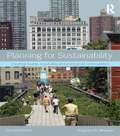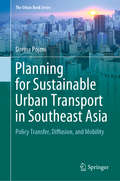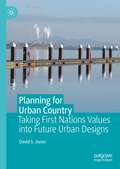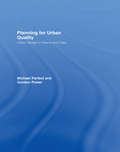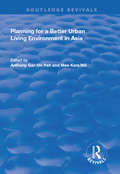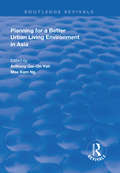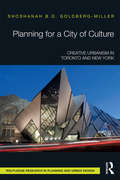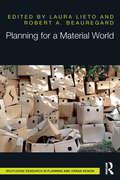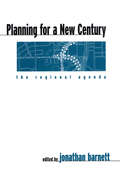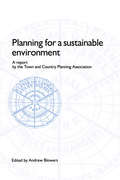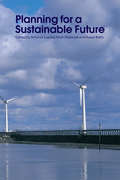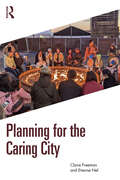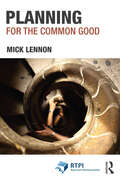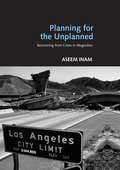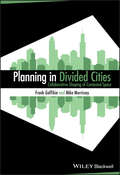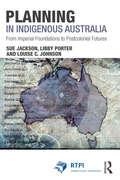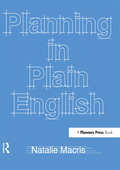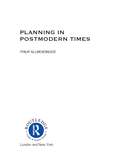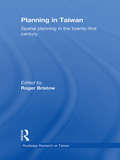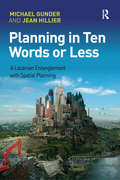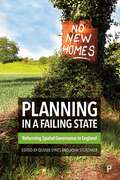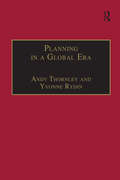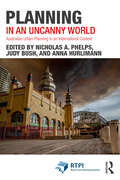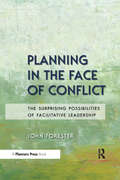- Table View
- List View
Planning for Sustainability: Creating Livable, Equitable and Ecological Communities
by Stephen M. WheelerHow can human communities sustain a long-term existence on a small planet? This challenge grows ever more urgent as the threat of global warming increases. Planning for Sustainability presents a wide-ranging, intellectually well-grounded and accessible introduction to the concept of planning for more sustainable and livable communities. The text explores topics such as how more compact and walkable cities and towns might be created, how local ecosystems can be restored, how social inequalities might be reduced, how greenhouse gas emissions might be lowered, and how more sustainable forms of economic development can be brought about. The second edition has been extensively revised and updated throughout, including an improved structure with chapters now organized under three sections: the nature of sustainable planning, issues central to sustainable planning, and scales of sustainable planning. New material includes greater discussion of climate change, urban food systems, the relationships between public health and the urban environment, and international development. Building on past schools of planning theory, Planning for Sustainability lays out a sustainability planning framework that pays special attention to the rapidly evolving institutions and power structures of a globalizing world. By considering in turn each scale of planning—international, national, regional, municipal, neighborhood, and site and building—the book illustrates how sustainability initiatives at different levels can interrelate. Only by weaving together planning initiatives and institutions at different scales, and by integrating efforts across disciplines, can we move towards long-term human and ecological well-being.
Planning for Sustainable Urban Transport in Southeast Asia: Policy Transfer, Diffusion, and Mobility (The Urban Book Series)
by Dorina PojaniBy now, planners everywhere know - more or less - what the ingredients of a sustainable city are, in theory. The problem is that only bits of solutions are being implemented in the cities that most need them, the majority of which are located in the Global South. This book examines issues related to policy transfer in urban transport planning in Southeast Asia. The metropolitan regions of four major capitals - Jakarta, Kuala Lumpur, Manila, and Bangkok - are considered. The book assesses the in-bound and out-bound transfer of sustainable transport planning policies, concepts, and tools. The investigation focuses on who transfers policy and why, what elements of policy are transferred, in what direction and to what degree, and what barriers does transfer face. It also discusses how policy transfer processes in the transportation planning arena can be improved.
Planning for Urban Country: Taking First Nations Values into Future Urban Designs
by David S. JonesPlanning for Urban Country addresses a major gap in knowledge about the translation of Aboriginal values and Country Plans into Australia’s built environment contexts. How do you ‘heal’ Country if it has been devastated by concrete and bitumen, excavations and bulldozing, weeds and introduced plants and animals, and surface, aerial and underground contaminants? How then do Aboriginal values and Country Plan aspirations address urban environments? In this book, David Jones explores the major First Nations-informed design and planning transformations in Djilang / Greater Geelong since 2020. Included are short-interlinked essays about the political and cultural context, profiles of key exemplar architectural, landscape and corridor projects, a deep explanation of the legislative, policy and statutory precedents, opportunities and environment that has enabled these opportunities, and the how Wadawurrung past-present-future values have been scaffolded into these changes.
Planning for Urban Quality: Urban Design in Towns and Cities
by Michael Parfect Gordon PowerRapid regeneration of city areas has placed the quality of urban design high on public and policy agendas worldwide. Planning for Urban Quality examines the achievement of quality in the urban environment, in a planning context. Tracing urban design from its roots, the authors draw on both historical and current practices to examine the key physical, political and economic forces at play and the social pressures and impacts brought about by both failures and achievements in urban design. This highly illustrated critique of towns and cities draws on examples from across Western Europe, South Africa and USA to examine both public and private sector development practices, controls and fiscal policies within a diverse range of localities. The authors indicate the need for a reinstitution of region-provincial approaches, for closer co-ordination bewteen sectors, and revised fiscal policies in planning and development in order to enhance the quality of urban social experience and environments. Providing a deeper understanding of the many diverse strands of Urban Quality, the authors provide a firm basis from which to analyse urban planning achievements and to assess the relevance and value of urban scapes.
Planning for Wicked Problems: A Planner's Guide to Land Use Law
by Eric J. Strauss Dawn JourdanEfforts to teach students pursuing graduate degrees in urban and regional planning are often frustrated by the "case books" that have been prepared for use by law professors teaching similar courses. ?Dawn Jourdan and Eric J. Strauss have attempted to take their concerns to heart in the design of this Planning for Wicked Problems: A Planner's Guide to Land Use Law. Each chapter begins with a planning problem that is complex and has no "correct" answer.? Students should answer this hypothetical before reading the subsequent sections of each of the chapters. The second section of each chapter provides a primer for each topic.? This primer is meant to summarize the basic principles of the law and to identify the types of questions relevant to planners when such issues arise.? The third section of each chapter includes a series of edited court opinions.? The cases selected have been identified by American Institute of Certified Planners as those fundamental to planning education. Each chapter concludes with an answer to the proposed wicked planning problem.? Planning for Wicked Problems has been written to demonstrate to future planners how the law may be a useful tool in helping them invent solutions to wicked planning problems. The book features a companion website for additional study and review.
Planning for a Better Urban Living Environment in Asia (Routledge Revivals Ser.)
by Mee Kam Ng Anthony Gar-On YehThis title was first published in 2000. Asia has developed very rapidly in the last quarter of the century and will be a main focus of the world in the 21st century. With rapid growth and development, the urban areas in the region are undergoing dramatic changes. An appreciation of the heterogeneous nature of Asian cities and the related planning practices is the first step to understand various urban development problems in the region. This book is a consolidated effort by prominent scholars in Asian planning schools to explore urban development and planning practices in Asia. The book reflects on and examines some of the past and current challenges and considers future prospects of urban and regional planning, environment, housing, redevelopment and conservation and planning education in Asia. This book should be useful to students, teachers, researchers and professionals and people who are interested in urban development, planning and environment in Asia.
Planning for a Better Urban Living Environment in Asia (Routledge Revivals)
by Mee Kam Ng Anthony Gar-On YehFirst published in 2000, this volume explores how Asia has developed very rapidly in the last quarter of the century and will be a main focus of the world in the 21st century. With rapid growth and development, the urban areas in the region are undergoing dramatic changes. An appreciation of the heterogeneous nature of Asian cities and the related planning practices in the first step to understand various urban development problems in the region. This book is a consolidated effort by prominent scholars in Asian planning schools to explore urban development and planning practices in Asia. The book reflects on and examines some of the past and current challenges, and considers future prospects of urban and regional planning, environment, housing, redevelopment and conservation, and planning education in Asia. This book should be useful to students, teachers, researchers, professionals and people who are interested in urban development, planning and environment in Asia.
Planning for a City of Culture: Creative Urbanism in Toronto and New York
by Shoshanah B.D. Goldberg-MillerPlanning for a City of Culture gives us a new way to understand how cities use arts and culture in planning, fostering livable communities and creating economic development strategies to build their brand, attract residents and tourists, and distinguish themselves from other urban centers worldwide. While the common thinking on creative cities may coalesce around the idea of one goal––economic development and branding––this book turns this idea on its head. Goldberg-Miller brings a new, fresh perspective to the study of creative cities by using policy theory as an underlying construct to understand what happened in Toronto and New York in the 2000s. She demystifies the processes and outcomes of stakeholder involvement, exogenous and endogenous shocks, and research and strategic planning, as well as warning us about the many pitfalls of neglecting critical community voices in the burgeoning practice of creative placemaking. This book is an essential resource in examining the development and sustainability of the global trend of integrating arts and culture in city planning and urban design that has become an international phenomenon. Perfect for students, scholars, and city-lovers alike, Planning for a City of Culture illuminates the ways that this creative city trend went global, with the two case study cities serving as perfect illustrations of the power and promise of arts and culture in current and future municipal strategies. Please visit Shoshanah Goldberg-Miller's website for more information and research: www.goldberg-miller.com
Planning for a Material World
by Robert A. Beauregard Laura LietoToday, urban scholars think of cities and regions as evolving through networks of human associations, technologies, and natural ecologies. This being the case, planners are faced with the task of navigating a profoundly material world. Planning with and for humans alone is unacceptable: in the unfolding of urban processes, non-human things cannot be ignored. This inclusive vision has consequences for how planners envision the connections among norms, technologies and life-worlds as well as how they design and implement their plans. The contributors to this volume utilize a variety of examples – ecologically-sensitive, regional planning in Naples (Italy); congestion pricing in New York City; and public participation in Europe, among others – to explore how planners engage a heterogeneous and restless world. Inspired by assemblage thinking and actor-network theory, each chapter draws on this "new materialism" to acknowledge, in quite pragmatic ways, that spatial politics is a process of becoming that is inseparable from the materiality of urban practices.
Planning for a New Century: The Regional Agenda
by Jonathan BarnettAcross the United States, issues such as sustainability, smart growth, and livable communities are making headlines. Planning for a New Century brings together leading thinkers in the fields of planning, urban design, education, welfare, and housing to examine those issues and to consider the ways in which public policies have helped create--and can help solve--many of the problems facing our communities. Each chapter identifies issues, provides background, and offers specific policy suggestions for federal, state, and local initiatives. Topics examined include: *the relation of existing growth management policies to social equity, as well as how regional growth management measures can make new development more sustainable *how an obscure technical procedure in highway design becomes a de facto regional plan *ways in which local governments can promote environmental preservation and better-designed communities by rewriting local zoning and subdivision ordinances *why alleviating housing shortages and slum conditions has resulted in a lack of affordable housing, and how that problem can be solved *how business improvement districts can make downtowns cleaner, safer, and more welcoming to workers and visitors In addition, the book features chapters on public safety, education, and welfare reform that include proposals that will help make regional growth management easier as inner-city crime is reduced, schools are improved, and concentrations of extreme poverty are eliminated. Planning for the New Century brings together current academic research with pressing public policy concerns, and will be a useful resource for policymakers at all levels of government, for planners and architects, and for students and scholars of urban planning and design, and urban studies.
Planning for a Sustainable Environment
by Andrew BlowersThis study explains how, confronting ever-greater environmental pressures, we can plan for and achieve a sustainable environment. The book focuses on urban development, as population and resources and often the most severe environmental problems are concentrated in cities. It looks at the nature of environmental planning and at the main areas where changes have to be made: in energy policy, waste disposal and pollution control, construction, transport and infrastructure. The book concludes with chapters on planning a sustainable city and on how to bring the necessary changes and institutional arrangements about.
Planning for a Sustainable Future
by Simin Davoudi Antonia Layard Susan BattySustainable Development is now firmly on the planning agenda and is an issue neither practitioner nor academic can afford to ignore. Planning for a Sustainable Future provides a multi-disciplinary overview of sustainability issues in the land use context, focusing on principles and their application, the legal, political and policy context and the implication of sustainable development thinking for housing, urban design and property development as well as waste and transport. The book concludes by considering how sustainable and unsustainable impacts alike can be measured and modelled, providing real tools to move beyond rhetoric into practice.
Planning for the Caring City
by Claire Freeman Etienne NelAs the world has become increasingly urbanised and planetary well-being ever more threatened, questions have emerged over just what the priorities should be for how we live in cities. Clearly for many the current ways of planning and managing city environments are not working, given so many of their human and non-human inhabitants struggle on a daily basis to maintain their well-being and survival. Different approaches to city development are crucial if they are to be inclusive places where all can thrive. Ensuring that cities are safe and sustainable and provide a level of care for all their residents places a significant mandate on those who manage cities and on planners in particular. This book examines all the parts of the city where care needs to be incorporated, how we plan, create nurturing environments, include all who live there, build sensitively, support meaningful livelihoods, and enable compassionate governance. With planners in mind this book examines why care is needed in the urban environment, and drawing on real world examples examines how it can be applied in an effective and empowering fashion.
Planning for the Common Good (RTPI Library Series)
by Mick LennonAppeals to the ‘common good’ or ‘public interest’ have long been used to justify planning as an activity. While often criticised, such appeals endure in spirit if not in name as practitioners and theorists seek ways to ensure that planning operates as an ethically attuned pursuit. Yet, this leaves us with the unavoidable question as to how an ethically sensitive common good should be understood. In response, this book proposes that the common good should not be conceived as something pre-existing and ‘out there’ to be identified and applied or something simply produced through the correct configuration of democracy. Instead, it is contended that the common good must be perceived as something ‘in here,’ which is known by engagement with the complexities of a context through employing the interpretive tools supplied to one by the moral dimensions of the life in which one is inevitably embedded. This book brings into conversation a series of thinkers not normally mobilised in planning theory, including Paul Ricoeur, Alasdair MacIntyre and Charles Taylor. These shine light on how the values carried by the planner are shaped through both their relationships with others and their relationship with the ‘tradition of planning’ – a tradition it is argued that extends as a form of reflective deliberation across time and space. It is contended that the mutually constitutive relationship that gives planning its raison d’être and the common good its meaning are conceived through a narrative understanding extending through time that contours the moral subject of planning as it simultaneously profiles the ethical orientation of the discipline. This book provides a new perspective on how we can come to better understand what planning entails and how this dialectically relates to the concept of the common good. In both its aim and approach, this book provides an original contribution to planning theory that reconceives why it is we do what we do, and how we envisage what should be done differently. It will be of interest to scholars, students and practitioners in planning, urban studies, sociology and geography.
Planning for the Unplanned: Recovering from Crises in Megacities
by Aseem InamFirst published in 2005. Routledge is an imprint of Taylor & Francis, an informa company.
Planning in Divided Cities (Real Estate Issues Ser. #55)
by Mike Morrissey Frank GaffikinDoes planning in contested cities inadvertedly make the divisions worse? The 60s and 70s saw a strong role of planning, social engineering, etc but there has since been a move towards a more decentralised ‘community planning’ approach. The book examines urban planning and policy in the context of deeply contested space, where place identity and cultural affinities are reshaping cities. Throughout the world, contentions around identity and territory abound, and in Britain, this problem has found recent expression in debates about multiculturalism and social cohesion. These issues are most visible in the urban arena, where socially polarised communities co-habit cities also marked by divided ethnic loyalties. The relationship between the two is complicated by the typical pattern that social disadvantage is disproportionately concentrated among ethnic groups, who also experience a social and cultural estrangement, based on religious or racial identity. Navigating between social exclusion and community cohesion is essential for the urban challenges of efficient resource use, environmental enhancement, and the development of a flourishing economy. The book addresses planning in divided cities in a UK and international context, examining cities such as Chicago, hyper-segregated around race, and Jerusalem, acting as a crucible for a wider conflict. The first section deals with concepts and theories, examining the research literature and situating the issue within the urban challenges of competitiveness and inclusion. Section 2 covers collaborative planning and identifies models of planning, policy and urban governance that can operate in contested space. Section 3 presents case studies from Belfast, Chicago and Jerusalem, examining both the historical/contemporary features of these cities and their potential trajectories. The final section offers conclusions and ways forward, drawing the lessons for creating shared space in a pluralist cities and addressing cohesion and multiculturalism. • Addresses important contemporary issue of social cohesion vs. urban competitiveness • focus on impact of government policies will appeal to practitioners in urban management, local government and regeneration • Examines role of planning in cities worldwide divided by religion, race, socio-economic, etc • Explores debate about contested space in urban policy and planning • Identifies models for understanding contested spaces in cities as a way of improving effectiveness of government policy
Planning in Indigenous Australia: From Imperial Foundations to Postcolonial Futures (RTPI Library Series)
by Louise C. Johnson Sue Jackson Libby PorterPlanning in settler-colonial countries is always taking place on the lands of Indigenous peoples. While Indigenous rights, identity and cultural values are increasingly being discussed within planning, its mainstream accounts virtually ignore the colonial roots and legacies of the discipline’s assumptions, techniques and methods. This ground-breaking book exposes the imperial origins of the planning canon, profession and practice in the settler-colonial country of Australia. By documenting the role of planning in the history of Australia’s relations with Indigenous peoples, the book maps the enduring effects of colonisation. It provides a new historical account of colonial planning practices and rewrites the urban planning histories of major Australian cities. Contemporary land rights, native title and cultural heritage frameworks are analysed in light of their critical importance to planning practice today, with detailed case illustrations. In reframing Australian planning from a postcolonial perspective, the book shatters orthodox accounts, revising the story that planning has told itself for over 100 years. New ways to think and practise planning in Indigenous Australia are advanced. Planning in Indigenous Australia makes a major contribution towards the decolonisation of planning. It is essential reading for students and teachers in tertiary planning programmes, as well as those in geography, development studies, postcolonial studies, anthropology and environmental management. It is also vital reading for professional planners in the public, private and community sectors.
Planning in Plain English: Writing Tips for Urban and Environmental Planners
by Natalie MacrisIn this volume, the author draws from more than a decade of editing experience to explain how to craft clear, understandable, and highly readable planning documents. The author suggests ways to overcome planners' most common writing foibles: acronymns, jargon, and overuse of the passive voice. And the author provides handy lists to transform mushy nouns into powerful verbs, pare down bloated sentences, and translate ""bureaucratese"" into everyday language. The author even includes practice exercises designed to help you recognize and overcome bad writing habits. But even the best writing skills won't help if your document is organized poorly and aimed at the wrong audience.The author also explains why it's essential to know who your readers are before you start writing and how to organize your work so that it will be easy to understand and use."
Planning in Postmodern Times (RTPI Library Series)
by Philip AllmendingerPostmodern social theory has provided significant insights into our understanding of society and its components. Key thinkers including Foucault, Baudrillard and Lyotard have challenged existing ideas about power and rationality in society. This book analyses planning from a postmodern perspective and explores alternative conceptions based on a combination of postmodern thinking and other fields of social theory. In doing so, it exposes some of the limits of postmodern social theory while providing an alternative conception of planning in the twenty-first century.This title will appeal to anyone interested in how we think and act in relation to cities, urban planning and governance.
Planning in Taiwan: Spatial Planning in the Twenty-First Century (Routledge Research on Taiwan Series)
by Roger BristowAs a newly industrialised country with highly successful economic growth and political liberation in a short period of time, Taiwan has been viewed as a model for other aspiring countries and regions. This volume focuses on the connection between planning institution and practice and the country’s future in terms of political institutions and economic and environmental sustainability. The book starts by providing a history of planning in Taiwan and situates contemporary Taiwanese planning in the wider global context. The contributors go on to cover challenges to planning, urban change, legal planning, land problems, the development of industrial land, community planning, conservation, ecological land use, planning for natural disasters and transportation planning. The conclusion discusses the challenges for Taiwan in the twenty-first century. Planning in Taiwan will be of interest to students and academics working on comparative planning, development and politics, urban studies and conservation.
Planning in Ten Words or Less: A Lacanian Entanglement with Spatial Planning
by Michael Gunder Jean HillierThis book takes a Lacanian, and related post-structuralist perspective to demythologize ten of the most heavily utilised terms in spatial planning: rationality, the good, certainty, risk, growth, globalization, multi-culturalism, sustainability, responsibility and 'planning' itself. It highlights that these terms, and others, are mere 'empty signifiers', meaning everything and nothing. Based on international examples of planning practice and process, Planning in Ten Words or Less suggests that spatial and urban planning is largely based on the construction and deployment of ideological knowledge claims.
Planning in a Failing State: Reforming Spatial Governance in England
by Olivier Sykes and John SturzakerThis topical, edited collection analyses the state of the planning system in England and offers a robust, evidence-based review of over a decade of change since the Conservative-led coalition government came to power. With a critique of ongoing planning reforms by the UK government, the book argues that the planning system is often blamed for a range of issues caused by ineffective policy making by government. Including chapters on housing, localism, design, zoning and the consequences of Brexit for environmental planning, the contributors unpick a complicated set of recent reforms and counter the claims of the think-tank-led assault on democratic planning.
Planning in a Global Era (Urban and Regional Planning and Development Series)
by Andy ThornleyGlobalization was the buzzword of the last decade. Advances in communication technology, computing and air travel have all contributed to the establishment of what has been referred to as a 'network society' that encompasses the globe. Such arguments clearly have a significance on planning - an activity which has been concerned with controlling and shaping the use of space. This volume brings together contributions from across the world in order to address some of the questions that arise from such global changes. The opening section addresses the globalization debate directly, raising some theoretical issues and exploring the planning implications across a range of world cities. This is followed by an exploration of the way the theoretical debate about planning may need to advance to encompass contemporary forces. A number of more specific accounts addressing the need for adaptation are offered. The final section focuses on two aspects - housing and sustainability - which persist as 'wicked problems' and are likely to remain at the top of the agenda in the third millennium.
Planning in an Uncanny World: Australian Urban Planning in an International Context (RTPI Library Series)
by Nicholas A. Phelps Judy Bush Anna HurlimannThis book places Australian conditions and urban planning centrally within comparative analysis of planning systems and cultures around the world to address issues including urban governance, climate change, transportation planning, regional development and migration planning. Australian urban conditions and their associated planning responses can and often have been seen as unique or exceptional. They are seldom discussed in the same breath as conditions and associated planning systems internationally. Yet, as well as being somewhat different from those elsewhere in the world, Australian urban conditions and planning responses are also somewhat similar. They are uncanny – strangely familiar yet unfamiliar. In this book, Australian urban conditions, and their planning policies and practices are informally compared and contrasted with those existing internationally. If Australian urban planning policy and practice have had limited influence internationally, the partial familiarity of challenges posed by its urban conditions ensure that Australia is a more important global reference point for scholarship and practice than commonly is appreciated. In this book the authors assert the potential and actual originality of urban planning scholarship arising from the Australian context. It will be useful for students and faculty, planners working in Australia, as well as anyone interested in international planning debates.
Planning in the Face of Conflict: The Surprising Possibilities of Facilitative Leadership
by John F ForesterBikers and hikers. Sex workers and social conservatives. Agencies and activists. The people involved in planning for a site—or a community—can be like the Hatfields and McCoys. And the process brings them together face to face and toe to toe. How can planners take conflicted communities from passionate demands to practical solutions? Facilitative leadership offers helpful answers. Cornell University’s John Forester has produced a dozen profiles of planning practitioners known for their successes in helping communities turn contentious conflicts into practical consensus. This remarkable book tells their stories in their own words. Lisa Beutler shows the way she got California’s off-highway vehicle users and recreationists on the same track. Michael Hughes shares the search for common ground for HIV prevention in Colorado. Shirley Solomon recalls how lessons learned in South Africa helped her build trust between Native Americans and county officials in the Pacific Northwest. Forester and his panel of experts offer no simplistic formulas but a great deal of practical guidance. From mind mapping to the Hawaiian concept of Ho’ oponopono (making things right), readers will come away with a wealth of ideas they can use to move from the heat of confrontation to the light of creative solutions in their communities.
